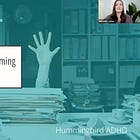ADHD Myths: Only Boys Have ADHD
Hey friend—this newsletter is supported by readers like you. If you love it or find value from it, consider becoming a paid supporter! You’ll unlock every article in the archive and gain full access to the Member Resource Hub. ADHD Myths: Only Boys Have ADHD🔍 Debunking the myth and exploring how gender bias has left many women with ADHD struggling in silence, by Meredith CarderI’m so excited to share this week’s ADHD Myth column, written by my friend, Meredith Carder! Meredith is an ADDCA-trained ADHD coach and author of the brand new book, It All Makes Sense Now: Embrace Your ADHD Brain to Live a Creative and Colorful Life which is available now! She is also an ADDCA-trained ADHD coach, a creator of helpful/relatable content on Instagram (@hummingbird_adhd), and was recently a guest speaker for Extra Focus, teaching on ADHD Overwhelm: ADHD Myths: Only Boys Have ADHD I’ll never forget the day I received my official ADHD diagnosis. After spending a few years feeling “almost positive” I had ADHD, I expected to feel relief and validation upon the confirmation of my diagnosis by a medical professional. Those feelings were present, but among them was another I didn’t expect… anger. How could I have been missed as a child when the signs now seem so obvious? As I began to dive into research on ADHD, the answer to that question became abundantly clear. I was just one of many girls and women that fell victim to the myth that “Only boys have ADHD”. In 2024, most people are aware that ADHD isn’t exclusively a condition affecting boys but while the myth itself has started to be much less prevalent, stigmas and misconceptions continue to surround the topic of ADHD among girls and women. A glimpse into the origins of the myth “Only Boys Have ADHD”The first descriptions of ADHD, historically referred to as “hyperkinetic reaction of childhood,” were based on studies of predominantly male children. This male-centric focus led to the development of diagnostic criteria that emphasized externalizing behaviors like hyperactivity and impulsivity, which are more readily observed in boys. In fact, it wasn’t until the 90s that girls began being included in research in a significant way. Knowing this, it doesn’t feel as surprising that so many women and girls were missed in the 80s, 90s and early 2000s. Even as girls began being included in research, they still remained underdiagnosed. Socialization and gender norms play a significant role in this disparity in diagnostic rates. From a young age, girls are often encouraged to be more quiet, compliant, and socially attuned, which can mask symptoms of ADHD. Girls with ADHD may be more likely to internalize their struggles, leading to anxiety, depression, or low self-esteem, rather than displaying overt hyperactivity. This internalization can result in teachers, parents, and even clinicians overlooking their symptoms. Even today, if a girl “isn’t a behavior problem” at school, they are unlikely to be identified by school staff or parents as in need of an evaluation. Unfortunately, just because a child isn’t a “problem” at school doesn’t mean that they aren’t experiencing intense struggles due to ADHD symptoms. Women and girls continue to be impacted by the consequences of the myth that only boys have ADHDWhile ADHD awareness around girls and women has grown significantly in the last several years, there is still damage left in the wake of this myth. Many women have spent decades of their life living with a brain they don’t have the proper instruction manual for. They have been misdiagnosed with other disorders or had their concerns invalidated by providers. Many have become excellent at masking their struggles but at great cost to their self-esteem and well-being. We need to keep talking about girls and women with ADHDEven with the growth in ADHD awareness, women are still underrepresented in research and literature on ADHD. There are huge knowledge gaps in areas like the impact of hormones on ADHD that need to be studied and narrowed. Women are continuing to be told that the symptoms they have struggled with since childhood are just a result of the stressful world we live in today. Others are faced with years-long waitlists to see a skilled provider for a diagnosis. Women and girls deserve better. We must keep raising awareness around ADHD and dispelling the myths that keep too many girls and women from truly understanding their ADHD brain. When I began diving into ADHD information, I was frustrated by the fact that so few books on the topic were written by women with lived experience of ADHD. Many years later, after transitioning my career into ADHD coaching and advocacy, I am thrilled to have written the book I was looking for when I was first diagnosed. It’s called “It All Makes Sense Now” and you can find it here. — Meredith Carder ADHD Myths SeriesThis newsletter is supported by readers like you! Become a paid supporter to unlock every article in the archive and gain full access to the Member Resource Hub. |
Similar newsletters
There are other similar shared emails that you might be interested in:




